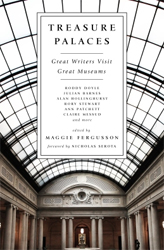
The Many Ways in Which the Heart Can Break
Aminatta Forna Visits the Museum of Broken Relationships
This piece was originally published in Intelligent Life, the ideas, lifestyle and culture magazine of The Economist Group, which is now known as 1843 magazine.
As I enter the room, a kissing couple draw quickly apart. He crosses to study something on the other side of the small room; she studies the description on the display in front of her. He’s wearing a hooded sweatshirt; she has a red bag slung around her. As they’re very young, it seems unlikely that they are having an illicit affair, so perhaps I have just embarrassed them.
After they are gone, I look at the exhibit they were standing in front of. It’s a broad-bean heater. “There’s a saying in Egypt that broad beans are best served warmed up,” reads the tag. “Our relationship never got warmed up, but the friendship remained as strong as dried broad beans.” The relationship, the tag explains, lasted from 1990 to 1991, so it coincided with the war of independence here in Croatia. I wonder whether the two things are connected—whether the war was the reason that this love foundered, or went unspoken, or missed its mark.
Against the opposite wall is a shaving kit given by a 17-year-old girl to her married lover in the late 1980s. When he donated it to this museum, the married man wrote: “I hope she doesn’t love me anymore. I hope she doesn’t know she was the only person I ever loved.”
Almost everything in the museum—room after white-painted room of illuminated display tables, stuffed animals, china dogs, silk dresses, coats and hats and books, ornaments of plastic or glass or ceramics, photograph albums, timepieces and domestic appliances—repeats the same message: that love ends in loss.
Love ends in loss, always. Only the broad-bean heater, still in its original box, suggests that a love unrealized may yet yield some measure of happiness.
* * * *
I first came across the Museum of Broken Relationships while walking through Gradec in the old town of Zagreb early last summer. I had come to trace the footsteps of characters in my new novel, The Hired Man, who move to this city and one day have lunch in the Hotel Dubrovnik. I had first imagined the scene, relying on written accounts of the hotel and of Tomislav Square, where they watch the 100-year-old trees being felled. Later, I’d come to Zagreb with my husband to walk the scene through, to make sure of my facts. The square and the hotel were close together, closer than I’d imagined, but the drive from Zadar to Zagreb took hours and by the time we arrived we were too late for lunch at the hotel. Instead, we wandered into the old town where, on a side street below St. Mark’s Square, we happened upon the museum.
On the right, as you enter, is a small café, on the left a gift shop and the ticket desk. Ahead of you lies a series of rooms, each bearing a name. Some are as fanciful as the names of racing thoroughbreds—Allure of Distance, Whims of Desire. From Rage and Fury you can turn right and pass through Tides of Time and into Rites of Passage, which in turn leads to Paradox of Home (wherein I found the guilty couple). If instead you walk straight through Rage and Fury you will come to Resonance of Grief, and the final room, Sealed by History. This part of the old town is mainly composed of municipal buildings, and the museum’s stone-floored rooms may formerly have served as offices. Resonance of Grief, whose walls bear old white tiles, looks as if it might once have been a urinal.
Next to each exhibit is a tag indicating where and when the relationship took place, and offering the donor’s explanation of the gift. So, in the first room, on the wall above a pair of black leather boots: “Biker boots. 1996-2003. Zagreb, Croatia. I bought this pair of boots for Ana before our trip to Paris. Later on, other girls wore them too, but they always remained Ana’s boots.”
* * * *
Olinka Vistica and Drazen Grubisic, the museum’s founders, were once a couple in love. One hot summer some years ago they stopped being in love and began to divide the contents of their apartment. Theirs had been an amicable split, though no less sad for that, and so they sorted through the rooms together, parsing shared memories of their relationship. Cups, CDs, ashtrays, coffee grinders, pans, rugs, books, badges, scarves: “Even the most banal object [had] a story to tell.” These were the sorts of objects every well-meaning friend, every self-help manual, every magazine article offering advice on how to recover from heartbreak urged people like them to throw away, burn, break or give to charity—to get rid of at all costs. When love ends there must be no reminders. But this pair didn’t wish to do any such thing. They wondered at the mercilessness of disposing of the evidence of love that may have given years of joy and much pleasure. They decided to curate a traveling exhibition of donated items, to offer bereft lovers the chance to create a ritual, an alternative to the vandalism proposed by the self-help manuals—“a chance to overcome an emotional collapse through creation,” as the printed sign above Ana’s boots tells newcomers. Since then, the first collection of objects has multiplied many times, finding a permanent home in Zagreb. A traveling exhibition has toured the world, collecting objects as it goes, offering the broken-hearted, betrayed and bereaved of Buenos Aires and Berlin, of Cape Town, Istanbul, Houston and even of Sleaford in Lincolnshire a chance to share the stories of their items.
It seemed to me, on my first visit, that Olinka and Drazen had hit on something—for what is there to do with all those objects one can no longer bear to look upon? Our homes are filled with fetishes: heirlooms, gifts, things we bring back from distant lands, all imbued with emotion. There on my bookshelf is the blue tin teapot from Timbuktu, on the mantelpiece a carved stone given to me by a beloved godchild, in the kitchen the collars of dead dogs hanging from a peg. All these accumulated totems, heaved over the course of a lifetime from home to home, are the physical evidence of having lived: our memories made solid.
When I met my husband he gave me a die-cast medal showing the Tibetan animal horoscopes, which he’d bought on his travels. I put the medal on a key-ring and carried it around the world; I had it with me when I bought the teapot in Mali. In return I gave him a talisman of my own, a small brass figure from Sierra Leone which, to this day, he too keeps on a key-ring. In The Hired Man a young boy, Duro, is given a small ceramic heart by his first love. It remains in his pocket during the years of his military service and even when she is married to someone else. Exchanging tokens of our love is something we all do.
* * * *
It was winter when I returned to Zagreb. Empty lots housed great mounds of snow shifted from the streets. Gone were the outdoor cafés and street vendors. I found myself booked, by coincidence, into the Hotel Dubrovnik, where the older citizens of Zagreb, wearing hats and coats with fur collars, were taking their morning coffee in the café exactly as they must have been doing since the hotel was built in 1929.
After breakfast I set off for the museum with a map, uncertain I could remember the way. The map took me a different route, past the cathedral, into which I wandered briefly to view the statues of the saints, and through the Stone Gate, beneath whose arches lies a shrine to the Madonna. In one corner, a woman was selling candles, while another woman prayed in front of a painting contained behind ornate iron railings. In 1731 a great fire destroyed the old wooden gate and everything that surrounded it, except, so the legend goes, the painting of the Madonna and Child, which is therefore believed to possess magical powers.
How like worshippers are the visitors to the museum, standing with heads bowed and hands clasped, moving slowly and silently from one relic to the next. It’s a weekday morning, and the place is relatively empty. There are just a handful of young couples, and a few middle-aged women wearing the kind of chic travel clothing favored by the French and Italians. Seven out of ten of the museum’s visitors are women, I’m told, and most are under 40.
* * * *
In the first room, alongside Ana’s boots, are items that carry the memory of love which has passed and for which there is no place in the landscape of a new love. The mood is of longing. The objects in the next room carry memories of pain—greater, it would seem, than the love that preceded it. Behind a crystal curtain in Whims of Desire a pair of fake breasts juts from the wall, donated by a woman whose husband obliged her to wear them during love-making, until she left him. An axe has been sent from Berlin by a woman whose lesbian lover left her for another. While the two were on holiday together, the abandoned lover bought this axe. “In the 14 days of her holiday, every day I axed one piece of her furniture.” She arranged the pieces neatly, waited until her former lover came back to collect her belongings, then showed them to her.
I move on swiftly towards the back room, where I am drawn by a red light that flashes from one of the display tables. In front of it is the young couple I’d caught kissing earlier. They are standing with their arms around each other’s waist, and she has her head on his shoulder. When they move on a few moments later, I take my turn to look at the flashing object.
Here is a story to make you cry. After 13 years, when their love has mellowed into friendship, a husband leaves his wife. She takes their little dog with her, because the husband feels she needs the comfort more than he. For months he suffers from depression, perhaps he misses her, we are not told. Whatever he feels, he does not return to the marriage. She worries for him. One day he receives a package from her containing a few small things, each of which, he says, “broke my heart a little more and were mostly about her wanting to take care of me, even though she was the one suffering.” Among them was a dog collar with a red flashing light, which she had bought for the dog so that he should never get lost. In the year since they parted the husband had spoken to her of feeling “lost.” After they have been apart for a year, his wife checks into a hotel in a strange town. There she takes her own life. The flashing light, he says, reminds him of her heartbeat.
As I walk round the museum, it’s stories like this—shocking, arresting, upsetting—that absorb my attention. Reflecting on the place later, I find my thoughts returning to less dramatic exhibits: Ana’s boots, or the wedding album donated by a woman who was miserable in her first marriage, but is now happy in her second. Thinking about these, I feel cautiously uplifted. They seem to show that, however long it takes and however painful the process, people can learn about themselves, and about love.
I cross Jelačić Square, which used to be called Republic Square, and I think how in most ways this country, after years of communism and then the war, feels unchanged from when I first came here, in 1969. I remember the holiday vividly though I was only five years old—standing on a beach with my sister, while my mother and her new husband called to me from a wooden boat offshore to swim to them. I was frightened: I wanted my rubber ring, but it was on the boat and between us lay 50 meters of water. The boatman’s nephew, who must have been eight or nine years old, picked up my rubber ring, dived into the water and brought it to me. For the rest of the holiday, he was my hero. I remember, because it was the very first time I ever felt that way about a boy.
How much there remained to know.

From Treasure Palaces: Great Writers Visit Great Museums, edited by Maggie Fergusson. Copyright © 2016. Available from Economist Books, an imprint of Perseus Books, LLC, a subsidiary of Hachette Book Group, Inc.
Aminatta Forna
Aminatta Forna is the author of the novels Ancestor Stones, The Memory of Love, and The Hired Man, as well as the memoir The Devil That Danced on the Water, and the essay collection The Window Seat. Forna’s books have been translated into sixteen languages. Her essays have appeared in Granta, The Guardian, The Observer, and Vogue. She is currently the Lannan Visiting Chair of Poetics at Georgetown University.



















